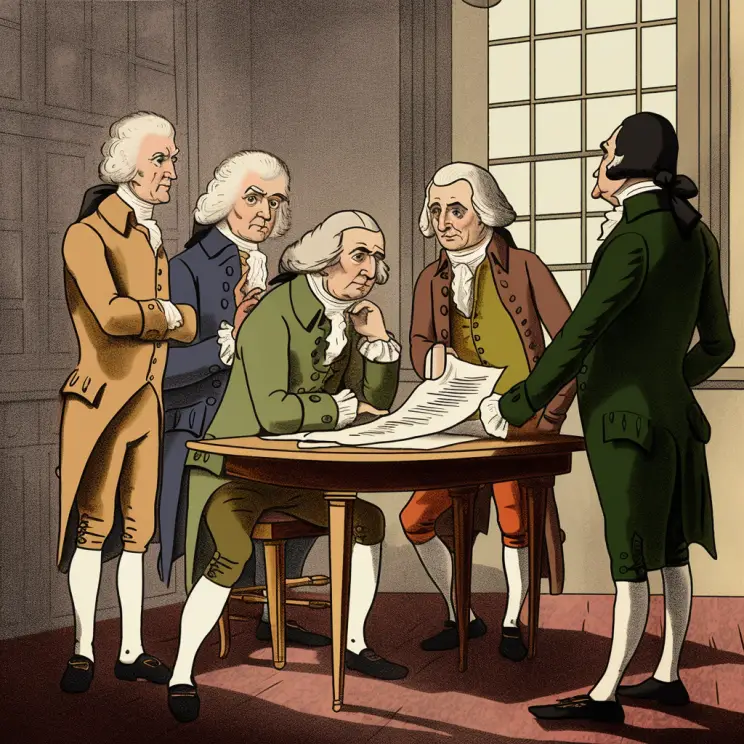Bill of Rights
Bill of Rights Simplified for Kids
On March 4, 1789, America officially adopted the United States Constitution, which established the U.S. as a free nation governed by the people.
The Constitution explains the country’s legislative, executive, and judiciary branches, defining the roles of the following:
- Congress
- Senate
- House of Representatives
- President
- Vice President
- Supreme Court

While the Constitution immediately proved to work better than the previous Articles of Confederation, it quickly became clear that changes would be necessary.
Needing two-thirds of the votes from both houses of Congress, the Senate, and the House of Representatives, changes to the Constitution could be made in the form of Amendments.
Bill of Rights Facts for Kids
- Freedom of speech
- Right to bear arms
- Protection from cruel punishment
- Right to a fair trial
- Protection from unreasonable searches
- Right to practice religion
- Protection of private property
- Right to a speedy trial
- Protection from self-incrimination
- Right to peacefully assemble
What is the Purpose of the Bill of Rights?
The Bill of Rights is like a list of rules that helps protect important freedoms and rights that people have, like the freedom to choose their own religion, say what they want without getting in trouble, own weapons, have a fair trial with a jury, and other important things. It also says that some rights belong to regular people and some belong to the states where they live.
Why is the Bill of Rights Important?
The Bill of Rights is one of the most important documents in history. It set out some really big ideas that protected people’s basic rights, like the freedom to speak their minds and choose their own religion. These ideas are still important today and have had a big impact on how we live our lives.
How did the Bill of Rights become part of the Constitution?
To start following the Constitution, at least nine out of the 13 states had to say they agreed with it. But not all the states agreed right away. Some were concerned that it didn’t promise enough protections for the rights of the American people. They were also worried that the government would have too much power, and that the Constitution didn’t have enough limits to control that power.
The first ten Amendments to the Constitution
The first ten Amendments to the Constitution were passed in 1791 and are collectively known as the Bill of Rights. The ten Amendments included in the Bill of Rights allow the following rights and freedoms to all Americans.
First Amendment
The First Amendment grants freedom of speech, freedom of the press, freedom of assembly, and the right to protest.
Second Amendment
The Second Amendment grants the right to bear arms
Third Amendment
The Third Amendment states that soldiers cannot take over a home during war or peace without the homeowner’s permission.
Fourth Amendment
The Fourth Amendment protects Americans from unreasonable and unlawful search and seizure of property.
Fifth Amendment
The Fifth Amendment allows all citizens due process and states that a person cannot be forced to serve as a witness against himself when accused of a crime.
Sixth Amendment
The Sixth Amendment provides a speedy and public trial by jury for all who are accused of a crime.
Seventh Amendment
The Seventh Amendment also allows a trial by jury to be held for certain civil disputes.
Eighth Amendment
The Eighth Amendment prevents those accused of suffering cruel and unusual punishment.
Ninth Amendment
The Ninth Amendment states that no one’s Constitutional rights should be used to infringe upon the rights of another citizen.
Tenth Amendment
The Tenth Amendment provides each state with powers that are not specifically assigned to the nation’s government in the Constitution.
The need for Constitutional Amendments was apparent as soon as the Constitution was approved.
While the state delegates gathered in Philadelphia for the United States Constitutional Convention mostly agreed that the Constitution was necessary for the country to prosper, many of the leaders were not satisfied with the document as it was written.
Benjamin Franklin
Benjamin Franklin famously noted that he did not approve of everything written in the Constitution at the time of signing it.
However, he also stated that he likely never would. Because it was “near perfection” in his mind, though, he supported the document and encouraged his peers to adopt the policies it contained.

George Mason, on the other hand, requested that a separate Bill of Rights should be added later.
Many others agreed with him, and the Constitution was then submitted to the states for approval, a process that took nearly two years.
James Madison

On June 8, 1789, three months after the Constitution went into effect, James Madison proposed a Bill of Rights to Congress.
Although he reiterated the need for some changes to be made, he also expressed his fear that the entire Constitution could be altered someday.
Few leaders wanted to see the ideals and structure of the Constitution changed in any way.
Madison stated that the Constitution itself was sound, but many thought it did not specify individual rights and protections well enough.
He then proposed a list of changes, which the House of Representatives redrafted into seventeen Amendments in August of 1789.
The House sent this proposal to the Senate, suggesting the Amendments be added separately to the Constitution and not placed into the body of the original document.
The Senate edited this draft, changing it to twelve Amendments. A joint resolution was reached in September, and the Bill of Rights was sent to states.
Three states approved it by the end of 1789, with another six approving in 1790.
The Bill of Rights officially went into effect after Virginia’s approval in 1791.
Two of the articles were rejected by a number of states, however, leaving the Bill of Rights at an even ten Amendments.



